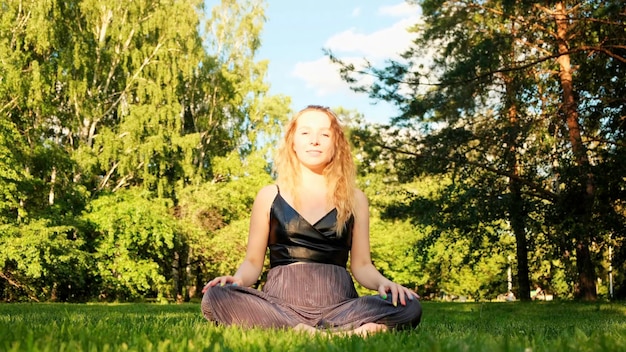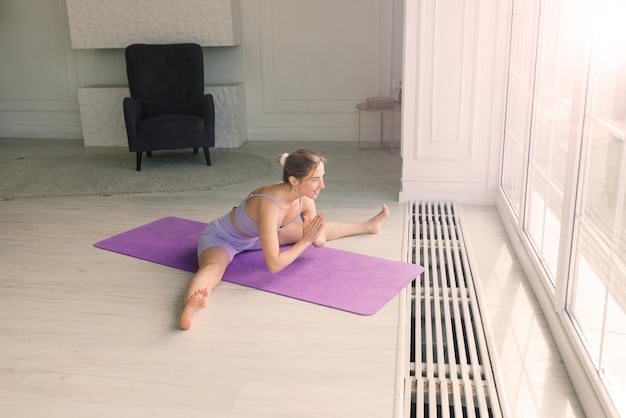Yoga for Mental Health: Reduce Anxiety & Depression Naturally

Yoga for mental health offers a holistic approach to alleviating anxiety and depression, integrating physical postures, breathwork, and mindfulness to promote emotional well-being and reduce stress.
Discover how yoga for mental health: reducing anxiety and depression through movement can be a powerful tool for finding calm and improving your overall well-being. This guide explores yoga’s benefits and how to incorporate it into your life.
Understanding Yoga’s Impact on Mental Well-being
Yoga is more than just physical exercise; it’s a practice that unites the mind, body, and spirit. Its impact on mental well-being is profound, offering a holistic approach to managing stress, anxiety, and depression. But how does it work?
By understanding the mechanisms behind yoga’s positive effects, we can appreciate its potential as a valuable tool for mental health. It combines physical postures with breathing techniques and mindfulness to create a powerful synergy that benefits both the body and mind.
The Mind-Body Connection
Yoga emphasizes the connection between the mind and body. Physical postures (asanas) release tension held in the body, which can directly impact mental states. When the body is relaxed, the mind can also find calmness.
Breathwork and the Nervous System
Pranayama, or breath control, is a key component of yoga. Specific breathing techniques can influence the nervous system, shifting it from a state of stress (sympathetic nervous system) to a state of relaxation (parasympathetic nervous system).
- Reduces Cortisol Levels: Yoga helps lower cortisol, the stress hormone.
- Increases GABA Levels: Studies show yoga can increase GABA, a neurotransmitter that promotes relaxation.
- Enhances Mindfulness: Regular practice cultivates present moment awareness, reducing rumination and worry.
In summary, yoga’s benefits extend far beyond physical fitness, touching on fundamental aspects of mental well-being by harmonizing the mind and body.
Yoga Poses for Anxiety Relief
Certain yoga poses are particularly effective at relieving anxiety. These asanas help ground the body, calm the mind, and release physical tension associated with stress. Practicing these poses regularly can create a sense of inner peace and stability.
By incorporating these poses into your routine, you can proactively manage anxiety and cultivate a more relaxed state of being. Remember to listen to your body and modify poses as needed, especially when starting out.

Child’s Pose (Balasana)
Child’s pose is a deeply restorative pose that calms the nervous system. It gently stretches the hips, thighs, and ankles while promoting relaxation in the forehead and shoulders.
Forward Fold (Uttanasana)
Standing forward fold releases tension in the hamstrings and spine, encouraging a sense of grounding. It can also help quiet the mind by gently inverting the body.
- Legs-Up-the-Wall Pose (Viparita Karani): This pose calms the nervous system.
- Corpse Pose (Savasana): This relaxation pose reduces anxiety and promotes relaxation.
- Cat-Cow Pose (Marjaryasana to Bitilasana): This gentle flow relieves stress and calms the mind.
Practicing these poses regularly can help reduce anxiety by promoting relaxation, grounding the body, and calming the mind.
Yoga for Depression: Finding Light Through Movement
Yoga can be an effective adjunct therapy for depression, helping to lift mood, increase energy levels, and foster a sense of hope. Specific yoga practices can stimulate the nervous system and release endorphins, the body’s natural mood boosters.
Finding light through movement is a powerful way to combat the darkness of depression. Yoga offers a safe and accessible path to reconnect with your body, mind, and spirit, fostering a sense of well-being and empowerment.
Backbends for Energy
Gentle backbends can uplift the spirit and energize the body. They open the chest and encourage deeper breathing, which can alleviate feelings of sadness associated with depression.
Twists for Detoxification
Twisting poses help to detoxify the body and mind by stimulating circulation and releasing stagnant energy. This can help clear mental fog and promote a sense of lightness.
- Sun Salutations (Surya Namaskar): Helps with energy levels and uplifting the spirit.
- Bridge Pose (Setu Bandhasana):Strengthens the back and opens the chest.
- Warrior II (Virabhadrasana II): This pose builds self-confidence and resilience.
These practices provide a pathway to rediscover joy and vitality. Remember to be patient with yourself and celebrate small victories along the way.
Breathwork (Pranayama) Techniques for Mental Clarity
Breathwork, or pranayama, is a cornerstone of yoga that significantly impacts mental clarity. Specific breathing techniques can calm the mind, reduce anxiety, and enhance focus. Incorporating pranayama into your daily routine can promote mental well-being and emotional balance.
By mastering these techniques, you can unlock the power of your breath to transform your mental state. Practice regularly and observe the subtle shifts in your mood, focus, and overall sense of well-being.

Alternate Nostril Breathing (Nadi Shodhana)
Nadi Shodhana balances the left and right hemispheres of the brain, promoting mental clarity and reducing anxiety. It involves alternating breaths between each nostril.
Ocean Breath (Ujjayi)
Ujjayi breath creates a calming sound in the throat, promoting relaxation and focus. It’s often used during asana practice to deepen awareness of the breath.
- Bellows Breath (Bhastrika): This energizing breath clears the mind.
- Skull Shining Breath (Kapalabhati): Enhances focus and concentration.
- Diaphragmatic Breathing: Reduces stress and promotes calm.
Incorporate these breathwork techniques into your daily life to reduce stress and increase focus.
Integrating Yoga into Your Daily Routine
Integrating yoga into your daily routine doesn’t have to be daunting. Even short, regular practices can yield significant benefits for mental health. Start with small steps, such as a few minutes of stretching or breathwork each day, and gradually build from there.
Consistency is key when it comes to experiencing the transformative effects of yoga. By making it a non-negotiable part of your daily life, you’ll cultivate a sense of well-being that permeates all aspects of your existence.
Morning Yoga
Starting your day with a gentle yoga practice can set a positive tone for the hours ahead. It can help ease stiffness, boost energy levels, and cultivate a sense of calm.
Evening Yoga
An evening yoga routine can help unwind after a long day, releasing tension and promoting relaxation before sleep. It can also help quiet the mind and alleviate anxiety.
- Set intentions: Start with a clear intention to find peace.
- Find a community: Connect with others on a similar journey.
- Be kind to yourself: Start with poses you are comfortable doing.
Start implementing these easy steps to begin your transition to better wellness.
The Science Behind Yoga and Mental Health
The positive impact of yoga on mental health is supported by scientific research. Studies have consistently shown that yoga can reduce symptoms of anxiety, depression, and stress. These findings highlight the physiological and psychological mechanisms through which yoga exerts its therapeutic effects.
By understanding the scientific underpinnings of yoga’s benefits, we can approach the practice with greater confidence and enthusiasm. The evidence-based research validates what practitioners have long known: yoga is a powerful tool for fostering mental well-being and overall health.
Studies on Anxiety
Research has demonstrated that regular yoga practice can lower cortisol levels, reduce heart rate, and improve sleep quality—all factors that contribute to reduced anxiety.
Studies on Depression
Yoga has been shown to increase levels of GABA, a neurotransmitter that helps regulate mood. It also promotes the release of endorphins, which have mood-boosting effects.
- Improved Mood: Yoga lifts the overall energy levels.
- Reduced Stress: Balances hormones related to happiness.
- Increased Self-Awareness: Helps you connect with your body.
Research shows how beneficial yoga can be to your health. Give it a try to improve your physical and mental health.
| Key Point | Brief Description |
|---|---|
| 🧘 Yoga for Anxiety | Specific poses like Child’s Pose can relieve tension and calm the mind. |
| ☀️ Yoga for Depression | Practices like Sun Salutations can boost mood and increase energy levels. |
| 🌬️ Breathwork Benefits | Techniques like Alternate Nostril Breathing can promote mental clarity and reduce stress. |
| 🗓️ Daily Integration | Incorporate yoga into your daily routine for sustained mental health benefits. |
Frequently Asked Questions
▼
Aim for at least 3-5 times a week, even if it’s just for 15-20 minutes each session. Consistency is key to experiencing the greatest mental health benefits.
▼
Yoga can be a helpful adjunct therapy, but it’s essential to consult with a healthcare provider. Medication might still be necessary, especially for severe cases.
▼
Yes, absolutely! Yoga is about progress, not perfection. Start with beginner-friendly poses and modifications, and gradually build your flexibility over time.
▼
Styles like Hatha, Restorative, and Yin yoga are often recommended for their calming and grounding effects. Experiment to find what works best for you.
▼
Both options are great! Practicing at home offers convenience and flexibility, while attending a class provides guidance and community support. Choose what suits your preferences and needs.
Conclusion
Incorporating yoga for mental health: reducing anxiety and depression through movement into your lifestyle can lead to significant improvements in your overall well-being. By understanding the science behind yoga’s benefits, exploring specific poses and breathwork techniques, and integrating these practices into your daily routine, you can unlock a powerful tool for finding calm, managing stress, and fostering a greater sense of inner peace.





